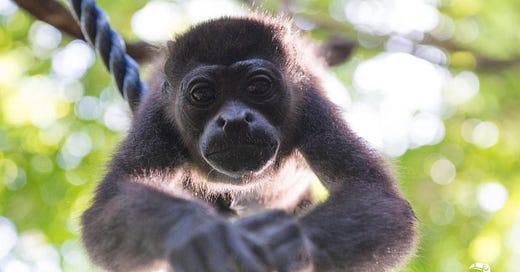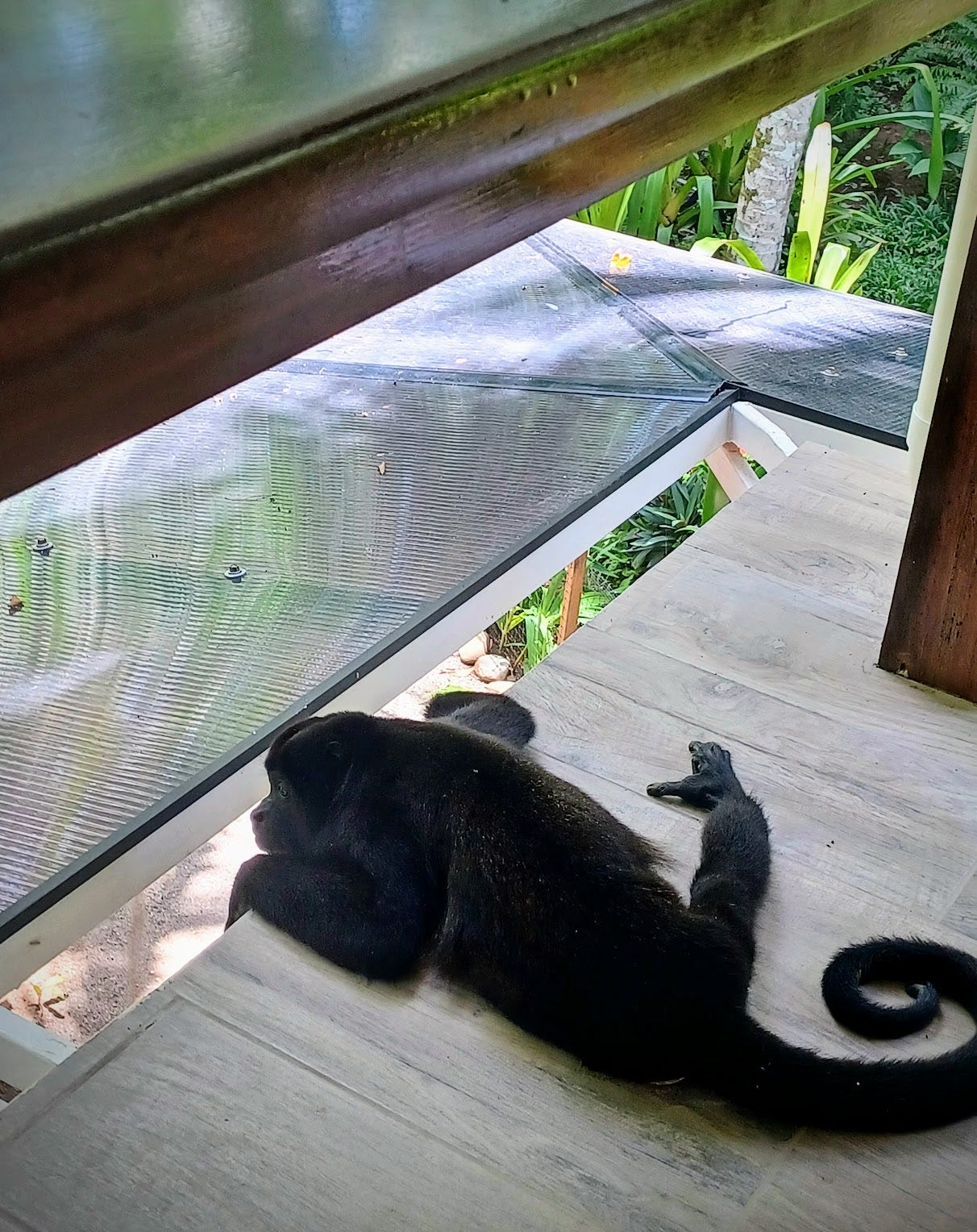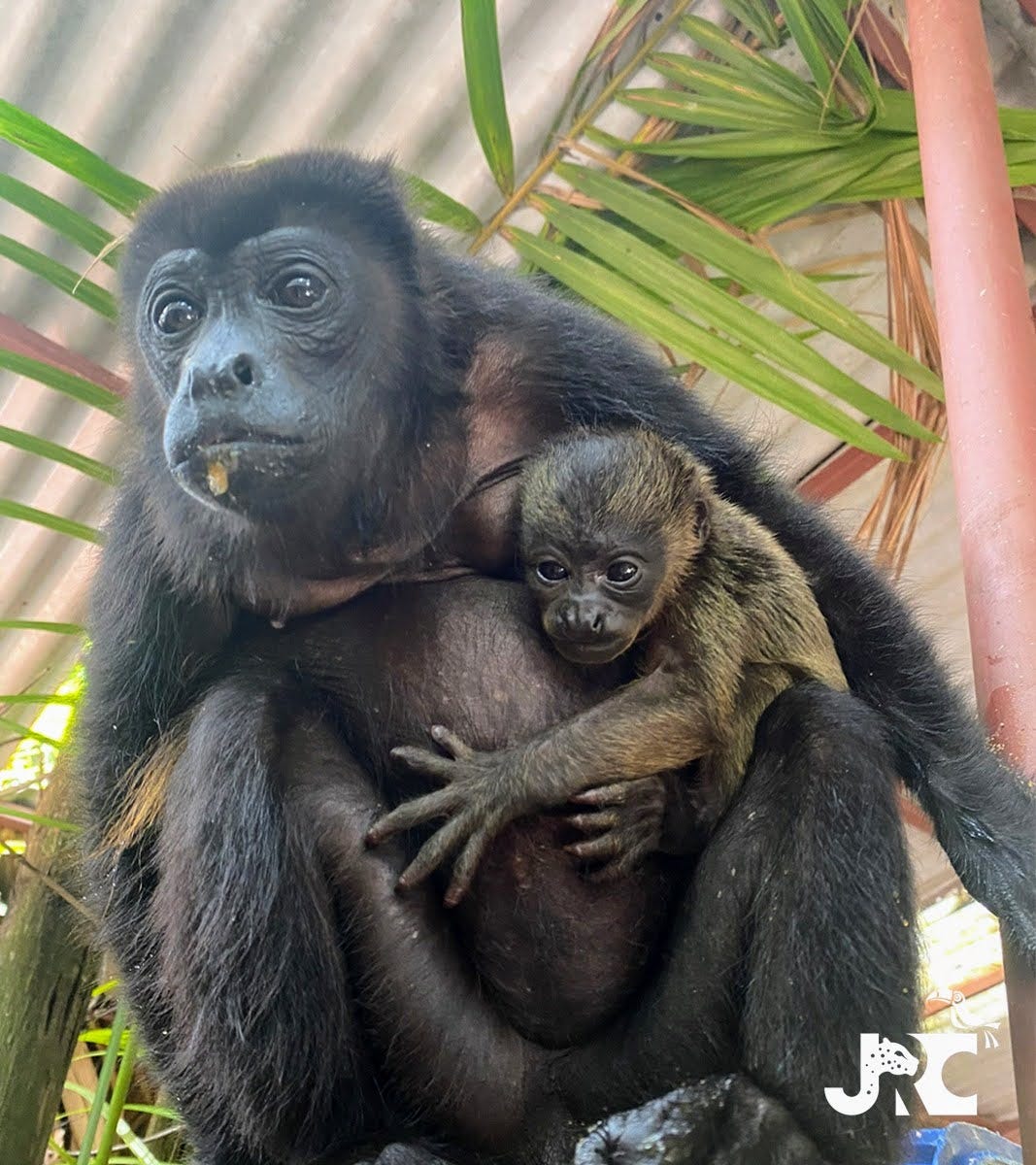I walked up the stairs to Encar’s house after writing in the cafe at the Jaguar Rescue Center (JRC) and just ahead of me, Saske, a male howler monkey, was climbing up the stairs to hang out at her house, too.
I got to know Encar — a primatologist and founder of the JRC — after studying plant medicine in Costa Rica and running Sacred Warrior Rewilding Retreats in collaboration with local teachers. The Jaguar Rescue Center was always an essential (and favorite) destination. Encar and I became close friends over the years and after a 4 year hiatus from Costa Rica, I’ve finally returned. This time to help (or more accurately, to learn how to help) with orphaned howler monkeys and to finish my book — a hybrid memoir told through the lens of other animals. Right now, I am revising my chapter about ‘fitting in.’ It features howlers and Saske’s tender and ongoing story has made it’s way into the book.
Saske was rescued by Encar when he was about 4 months old. He was found in the outskirts of the jungle alone with his hand cut off by a machete. It’s unclear whether his injury was accidental or was done on purpose. Whatever the reason, he was by himself, in incredible distress and in need of care.
After being rushed to the JRC hospital where his wounds were treated, Encar visited him as he healed to give him motherly love and attention. “A lot of rehabbers forget that love is everything when it comes to healing their trauma,” she told me. “Monkeys need to feel a sense of safety. They need living, breathing, loving contact. Physical contact is the key between survival and death.”
In the wild, howler babies receive constant support — food, love, touch and the education they need to survive on their own. Howler mothers only have one baby at a time and take great care of their young. Babies nurse and stay close for years, needing ongoing tenderness and care. So much so that when howler mothers are mortally wounded, baby howlers - unless adopted by a nurturing mom like Encar — rarely survive
As Saske healed at the hospital, he became friends with another howler monkey and when he and his friend were well enough, they were moved to the spacious monkey tower at the JRC rehabilitation center. Once there, they continued to recieve loving care and after a year in the tower, they were ready to spend time in the main howler pre-release enclosure at the JRC. In afternoons, the howlers enjoyed field trips to the jungle to climb trees, encounter their wild relatives and remember how it feels to be free.
Doing relatively well despite his injury, Saske moved on to the next stage: a pre-release enclosure in La Ceiba primary growth rainforest. He was moved with his best friend, a female howler, and after a week and half when they seemed ready, the JRC staff opened the door and released them. But it didnt go well for Saske. He was attacked by other monkeys who chased him to the end of a branch and forced to jump, he fractured his leg was rushed to the JRC hospital once again. “We tried,” Encar told me. “He wanted to go back out into the forest and have his own troupe but it was too dangerous. He doesn’t have the same opportunities in the wild with no hand" Marginalized by his injuries, Saske found it difficult to find safety and community in a wild troupe that would accept him.
"He is kind of a sad monkey," a volunteer at the JRC told me. “Sometimes it seems as though he connects and relates more to other animals — animals unlike him.” I imagine there is an ache for belonging in him but maybe his disability has also opened doors and offered him a life as a helper to other rescued monkeys. Not accepted into a wild troupe at La Ceiba (yet), he has opened himself up to friendship with animals — human and non-human — beyond his monkey kin.
Today, he has a good life at the JRC. Roaming free, he spends time with his former group — his first family — at the rehabiltation center where he’s served fresh organic fruit and veggies. Sometimes he hangs out other animals and with wild howlers, his new friends, who live closeby.”He knows he needs help because of his disability,” Encar tells me, “but his spirit is still wild and free.”
More about Saske’s species — Alouatta caraya — black howler monkey:
The black howler monkey’s cry can be heard for up to three miles, making the loudest vocal sounds of any land mammal. Male howlers call at dusk and dawn and throughout the day to create space in trees, come closer together, announce a nearby intruder, or warn another group member to stay away from their mate. Howler monkey troupes may include up to fifteen adult males and females with a dominant male and dominant female who helps him lead the group and keep everyone in order. While their voice can be intimidating, these primates are peaceful leaf-eaters who spend most of their lives swinging between trees. When young monkeys reach maturity, the troupe makes them go out on their own. During this period, the lone monkey wanders the jungle until they find another group willing to take them in.








What a wonderful group that spends their time and energy loving the parts of each of the animate world back to a sense of wild wholeness. Many things will compromise us but we will always hold resiliency if we continue to have love and deep compassionate care. Deepest bows to those who chose this “right livelihood”! 🙏💖
What a poignant story he has - thank you for sharing it with us! Sometimes we find belonging in unexpected places and with unexpected beings. How beautiful that he has the opportunity to connect with other animals - human and other-than-human. I am so glad he is getting the love and care that he is, and I hope he finds the balance of wild and tamed that works for his little howler monkey spirit :) (PS. Does "Saske" have a particular meaning?)